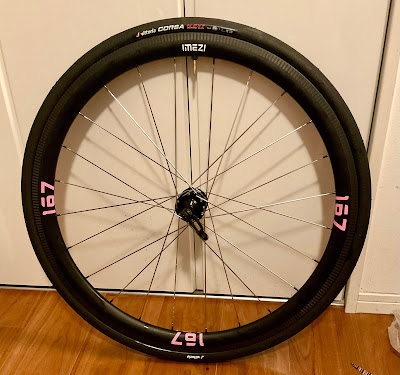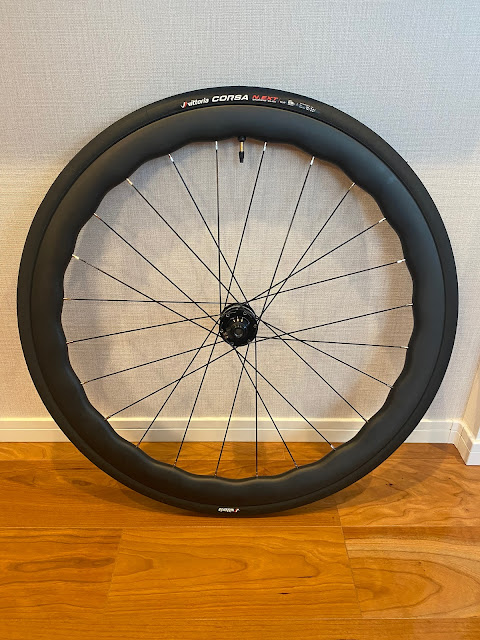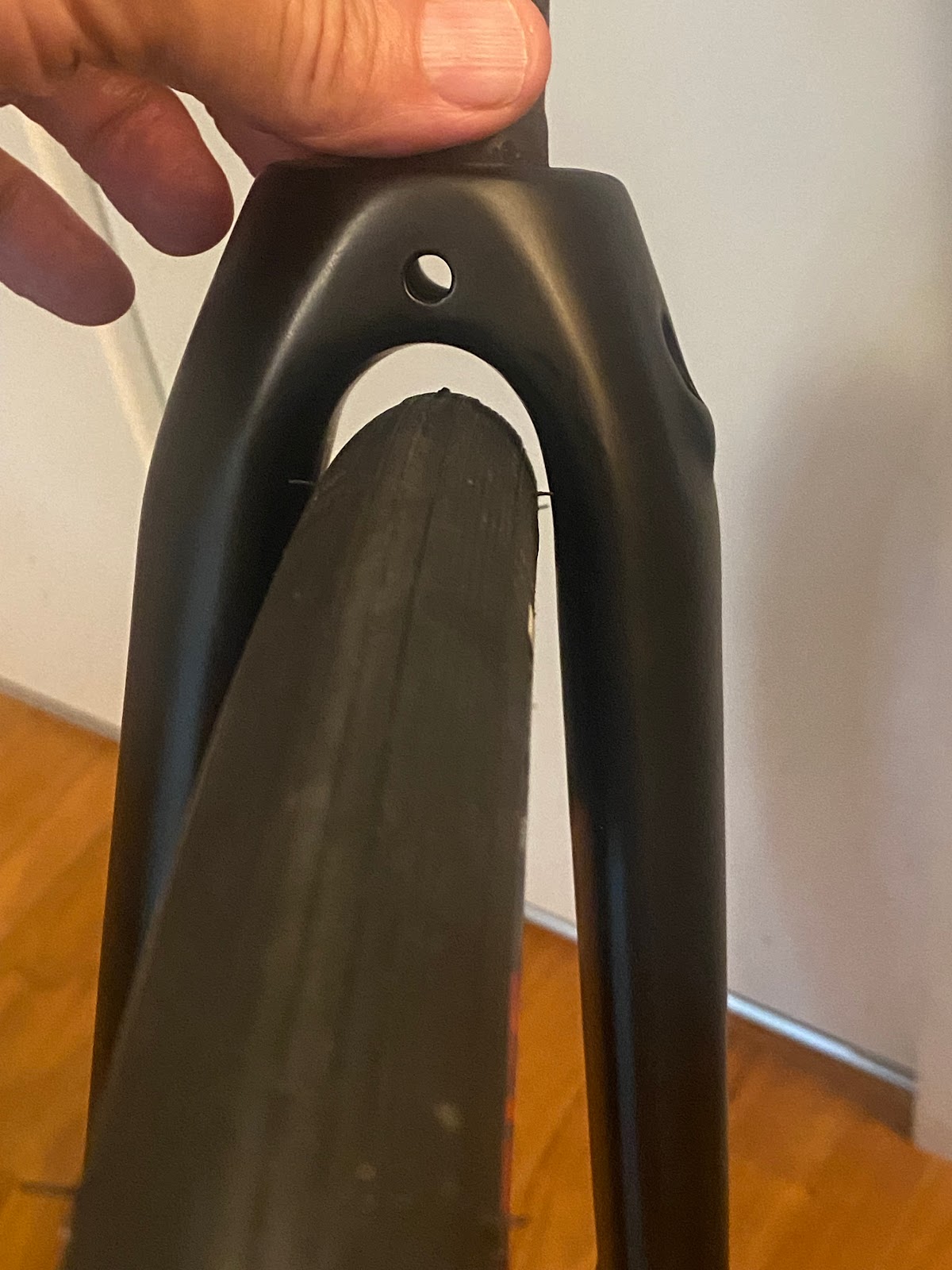Positivo Pages
31 July 2023
Wheel Nos 00030, 00031, and 00032
03 June 2023
Helmets -- An Update, and [Shimano] Lazer
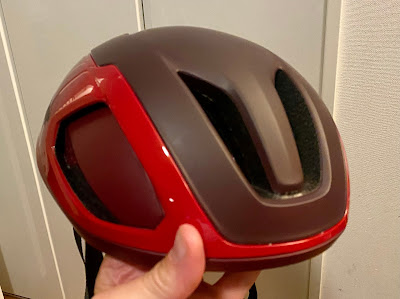 |
| New helmet - Lazer Vento Kinetocore |
Last September I wrote a brief review of my helmets when I discarded my ancient Giro Atmos and got a basic Bontrager Specter "wavecell". I have thought about it some more in the meantime. I think my perception of helmets varies significantly with the season/temperature and length of ride.
First -- one helmet that had been in storage and was not included in last year's review. It is a Bollé model I got some years ago. It is just a little too wide to fit snuggly on my head unless I am wearing a cap of some type underneath. It does, however, have some interesting features. First, you can latch on covers that block the vents on top of the helmet (there are still a couple small vents on the side). This makes the helmet a lot warmer in winter and also presumably improve the aerodynamics considerably. I used the Bollé this winter on the February Seattle Randonneurs' 200km brevet and some other rides, and I must say it is ideally suited to winter riding. The helmet also came with a removable thick felt lining that covers head and has generous ear flaps ... too warm in Tokyo for all but the coldest days of mid-winter. I still have that liner somewhere but have not been tempted to use it in years. If the Bollé were just a little bit narrower, I might use it in warmer weather without the vents covered ... Anyway, it probably has another few years of winter use in it before it needs to be discarded. (The US CPSC recommends replacing helmets after 5-10 years, even if not damaged, as the foam filling deteriorates over time).
 |
| Vent covers on! |
 |
| Vent covers off! |
 |
| Side view |
 |
| Vent covers |
Second -- last Fall I gave a relatively mixed/lukewarm review of the Giant Pursuit MIPS helmet. I have used it on a few rides recently and have adjusted it so that it fits a bit better and feels balanced on my head. It is still a bit heavy and bulkier than some, and it is still a very dirty white color.
Finally -- For PBP and other future rides, I finally bought a first-tier aero road helmet, the Lazer Vento Kineticore. "Kineticore" is Lazer's name for their crumple zone crash-protection tech, which gets 5 stars out of 5 from the Virginia Tech helmet crash testers. Lazer is a 100+ year old name in cycling helmets and was acquired by Shimano in 2017 or so. On the Worldcycle Japan domestic online site, it is listed as "Shimano Lazer" or, actually, シマノレーザー. Elsewhere it is just "Lazer".
 |
| The Vento |
 |
| Side view with reflective stickers |
 |
| The Kinetocore crumple zones. |
The helmet looks distinguished, I think. It fits perfectly, is very easy to adjust with an external adjustment mechanism on the back, and is easy to attach a rear LED light. There is even a decent place to stash glasses. And it is relatively light, as well as being designed for aerodynamics ... with decent airflow. I added some reflective stickers given the darkish cover, and affixed a rear light. I compared it with a number of other similar designs ... and it was 10-20% less expensive and available within Japan, but by no means cheap at around $180 equivalent.
 |
| Wout van Aert (aka WvA)! |
 |
| Jonas Vingegaard [correction - Marianne Vos] ... showing too much mouth. |
 |
| Christophe La Porte (winner stages 1 & 3, GC leader, Critérium du Dauphiné) |
Team Jumbo Visma uses the Lazer helmets which ... seems odd, given that they are not a Shimano team (they use Cervelo bikes and [Cervelo affiliated] Reserve wheels, with SRAM groupsets). Then again, Lazer is a Benelux company that downplays any Shimano connection; and Jumbo Visma is the #1 Benelux team. As the sponsors want to hear fans and consumers say, if it is good enough for [Wout/ Jonas/ Primoz/ Rohan/ Christophe ... ] then it is good enough for me.
Then again, Wout van Aert usually rides a Red Bull sponsored helmet ... he was using a different Lazer model until, at Tour de Suisse, he appeared with a Vento that has the Red Bull logo and color scheme.
 |
| WvA in his Red Bull Vento |
For a seriously hilly stage in warmer weather ... some of them opt for maximum ventilation rather than aerodynamics. I did not see Primoz Roglic using the Vento at last month's Giro. But they all seem to have the Vento at the Dauphiné ... and won 4 out of 8 stages, 3 wearing the Vento. Vingegaard used one on Stage 5, but had on a different Lazer helmet with full ventilation/less aero at the end of stage 7 -- a stage under 150kms in length but with over 4000 meters elevation gain. (Team FDJ also uses Lazer helmets.)
I hope that, with this new purchase, I will not be buying any helmets for the next couple years at least. I'll still use the Bontrager for my rides in town, and the Bollé for some rides in winter. The Giant Pursuit perhaps can see service as a backup, or for a TT-like effort.
22 May 2023
15 May 2023
World Record?! And If I had to do it all over again ...
1. Training.
I have ridden the standard Super Randonneur series this year - 200, 300, 400, and 600 km events - so I meet the basic condition to do a longer ride. Box checked. But only the 400km event was done this year with the Pelso. The rest were done with a normal road bike. I did ride the Pelso regularly in January for 3-4 weeks, and more recently on a few 100km training rides. But I have never done a multi-day ride on it. And I really should have done another 600k or even a 1000k on it before attempting to do this ride. It is a big jump to go from a 400km ride to a 1667km ride on a recumbent.
That said, I was happy that the reclined position and headrest really did mean I had no back, neck, groin or other pain ... except my "burnt toast" leg muscles, some ankle pain (that resolved each time when I pulled over and stretched my ankles some), and minor swelling of my hands the last day and for a few days after I finished.
Still, I should have done at least a 600km ride on the Pelso, and a 1000km ride on ANY bike this year, before trying to get a decent time on this long an event.
Also, I should have trained enough to lower my weight to "best" historical levels, in order to make the climbing easier and offer a somewhat better power/weight ratio. My weight at the start of the ride was close to my typical peak winter weight, probably due to two 5-6 week U.S. trips in late fall and winter.
2. More rest in advance; An earlier start in the evening.
I did not start this ride fully rested. At least I got decent sleep the last few nights before the ride, but on the morning of the 26th, I woke early, went to my university and taught an 830-1030AM law school class, met with some colleagues, then took the shinkansen all the way to Shimonoseki (5+ hours including a transfer to local train at Kokura), went to my hotel, walked 15 minutes to Yamato to pick up a large box with my wheels and seat, carried the large box all the way back to the hotel, spend the next 90+ minutes setting up the bike ... and before I knew it, it was time to leave and start the ride. I did get some "rest" on the shinkansen, but no sleep, and I ended up doing work on the train that I needed to complete before starting the ride. So while the excitement of starting the ride kept me going past dawn near Hiroshima, I was really, really tired the remainder of the first section to Okayama.
If I did this again, I would arrive a day in advance in Shimonoseki, get at least 10 hours sleep, spend a relaxed day including naps, and start at 7PM instead of 8:43PM. Traffic volumes were already dropping by the time I carried my wheel box back to my hotel, and I really would have liked to get past Hiroshima a couple hours earlier and all the way up into Higashi Hiroshima before morning rush hour.
3. Routing - dead ends, non-paved roads, high traffic volumes.
I did not "pre-ride" any sections of this trip. I used Strava's route mapping feature to select the "most direct", "least elevation" options, and only made minor tweaks from that course before transferring to Ride with GPS and importing from their to my Wahoo Elemnt Bolt. Overall, it worked out very well. And I had ridden at least various sections of the route before so as to have a good sense of many of the roads. Misawa-san (Philippe) warned me that Route 2 from Higashi Hiroshima to Mihara was not a good selection ... and he was right. There were too many trucks, and not enough shoulder. It was difficult to feel safe at times ... I walked up one hill just because of the trucks zooming by. If I did it again, I would look for an alternative route between Hiroshima and Mihara/Onomichi, if available.
Also, the coastal road just north of Tsuruga, Fukui, felt scary in the early evening after dark, with trucks and cars roaring by and no shoulder. But there is no better option I can find, and once I got 15kms or so from the Tsuruga, my route continued left along a deserted coastal road while 95% of the traffic headed right and up a hill on the main highway. From there north the route was awesome. But I would prefer to do that busy section just north of Tsuruga before dark, or maybe in the wee hours when there would be low traffic and trucks could pass by going far into the opposing lane.
Finally, I would have should have tried harder to avoid Route 2 in eastern Hiroshima, Okayama, and western Hyogo. There are parallel roads or even paths along rivers in some places that would be better, as I was basically stuck in traffic jams. I tried to "time the traffic lights" in many places, watching when they turned green or red, cutting my effort if it looked as if I would arrive to a red light, accelerating if I thought it might get me through before a green light changed. But it was impossible in heavy traffic of eastern Hiroshima and western Okayama prefectures.
There were a number of places where the Strava routing sent me onto a gravel rutted path. Once or twice this worked and proved a good alternative to a busy highway. Other times it was a big waste of time and required me to backtrack or hunt and peck in the dark for a route when the highway would have been much faster. A couple of times, Strava's route directed me to turn off a road and ... proceed through the middle of a field or flooded rice paddy. Other places, when I missed a turn and got slightly off course, Wahoo tried to route me back to the course by sending me ... along the edge of a dirt field that dead ended into a thicket of jungle, still 100 meters or more from the road I wanted to get to. Overall I wasted an hour or two with these kinds of issues.
I split the entire route into 5 sections for loading onto my GPS unit, but each of these was too data heavy for Wahoo to load "turn by turn" instructions. I should have split it into more sections and gotten the turn-by-turn instructions to save time when I was exhausted and missed a non-obvious turn. That tweak, plus an evening or two online going over the route very carefully using Google streetview etc and tweaking it, could have saved me an hour or two, at least.
4. Bike and gear.
The Pelso is a good "all around" recumbent. It is not the fastest, but it is relatively practical, relatively comfortable, relatively aerodynamic, and it survived the 1667kms. I do not have experience with other recumbents, and this was my first ride longer than 400kms on the Pelso, but I would make a few tweaks if I tried something like this again.
a. Steering column and handlebars. The steerer column protrudes quite far above the frame of the bike. I think I could cut this down 10 cms or more and it would help the aerodynamic profile of the bike a bit, still with enough room for my feet around the double "J" shape handlebars. The manufacturer confirmed that I could do this without affecting the integrity of the bike, but I did not have time to try. Another idea would be to replace the double J shaped bars with a steering "tiller" that protrudes less and allows one to ride with arms tucked in, thus lowering aero drag. But I would not want to do that without ample time for experimentation.
b. Wheels. I thought about potentially using a disk rear wheel ... or at least covering a wheel with monokote to fashion a home-made disk wheel, for better aerodynamics. I was glad I did not do this, given some strong gusts and cross-winds at many points along the way. But I would have liked a compromise -- a deeper-rimmed rear wheel with aero spokes. Also, the Velocity Aileron rims I used are optimized with 28mm wide profile tires, while I had 30mm ride tires. So different rims would have likely been faster, and more comfortable. This optimization could make a bit of difference that adds up over time. That said, I would keep my SP Dynamo front hub. On a ride of this length, the 5 watts or so of drag from the dynamo hub is more than compensated, in my view, by 24 hr x7 day bright front and rear lighting and no worries about batteries.
c. Helmet and clothes. Likewise, I did not use an "aero" helmet on this ride, but might if I wanted to save a few more watts. Riding a recumbent does not require cycling bib shorts -- no pad -- as you are not sitting on your groin area. Most days I wore running shorts. These were comfortable, but I should have chosen shorts that hugged my legs tightly, for aerodynamic purposes. I did have good arm and leg covers that are designed not to cause aerodynamic drag, at least.
d. Water bottle placement. When I ride the Pelso I usually place a water bottle in a holder that protrudes from the side of my Radical Designs rear bag. This time I pulled that holder closed with safety pins to reduce drag and instead carried two bottles in water bottle holders on the underside of my seat. Unfortunately, the bolts I used to attach the bottles protruded too far and scratched the bottles every time I tried to pull them out or return them. By the end of the trip, one of the bottles was leaking. The other probably has a very limited life left. Some more care setting up the bottle holders would have solved this problem. I think the under-seat location is ideal in terms of aerodynamics, even if harder to reach.
e. Tubeless tires. I was generally very happy with my tires -- Schwalbe Pro One 700x30mm TLR. They roll with low resistance and are comfortable. I lost air once in the rear tire just before Niigata, and in the front in Aomori. The first was likely due to a big dent in my rear rim. The second was some kind of puncture and IRC "respawn" sealant quickly sealed the leak. Overall, this was less trouble than one might expect on a ride of 1667kms, including two nights riding in the rain. Before I would do this again, however, I would try to get some experience "plugging" holes in tubeless tires. At least now I know how to use the "respawn" successfully.
f. GPS. My Wahoo GPS unit recorded the ride flawlessly. The battery life was plenty to make it through my 350km segments with only a short "top up" recharge mid-ride, and never got near empty. That said, I really should have run a parallel/back-up GPS recording in case of trouble, and would do so if I ever try another long ride to be validated by GPS. Over the course of a ride this long, as often as not there is SOME trouble with part of the GPS recording. And in this case, a GPS issue would have invalidated the record attempt.
g. Tighten bolts and check daily. The seat on the Pelso is attached directly to seat stays and frame, and it forms an important part of the structure of the bicycle. When I put the bike together in Shimonoseki, I tightened everything properly. But a few days later, in Niigata (or was it Akita), when I checked again, many of the bolts had worked a bit loose and I could retighten them at least several turns. I think this actually resulted in somewhat diminished confidence in bike handling and a "squishy" feeling at times that was accentuated when I was very tired. In the future I would check and tighten all the bolts daily.
h. Groupset. My Pelso has a 1X SRAM 11-speed groupset. 1X is ideal for a recumbent, as it simplifies the chain line, and avoids a front derailleur and double chainring sticking up on the front of the bike, and with the long chain I think the typical 1X problem of a chain that is consuming more watts drag when in the innermost or outermost gear is largely avoided. When I had my bike turned upside down to clean the chain and frame before leaving my Niigata hotel, I bumped the bike ... and the right (rear) brake lever mostly snapped off. From that point, I survived without any problem on a front brake and an at best a 25% functioning rear brake. ... The brake lever looked like a cheap piece of crap. Not sturdy. And the 11x46 rear cassette is probably near its replacement date ... though a clean chain helps it to last longer. The chain came with the bike and now has over 7000kms on it also. Anyway, if I want to experiment with a steering "tiller", I might as well upgrade the levers and even get a better grade of rear derailleur ... perhaps even electronic shifting? The Pelso is due for a bit of an upgrade.
Meanwhile, I will focus on riding my road bike(s) until I am done with Paris Best Paris!
09 May 2023
Japan Energy Tour -- Down Solar Memory Lane, the Nuclear Ginza, TEPCO's 7 plants, Aomori
My ride started as a solar PV tour, and ended up as a nuclear tour. Kind of like Japan's post-2011 energy policy? I don't actually have any photos of the sites I mention below ... because they were not close enough to be visible from the roads I took -- in the case of the nuclear plants, that is intentional.
I started in Shimonoseki, Yamaguchi Prefecture. I remembered driving all over Yamaguchi Prefecture back in 2013-2014 looking for solar project sites. Eventually my company started to develop one ... on the northern outskirts of Shimonoseki, at a closed campus of Baiko Gakuen, a women's college. Women's colleges and 2-year colleges are shutting down all over Japan, victims of demographics and trends toward co-ed 4 year university degrees.
Anyway, we got working on the project, submitted preliminary applications to the utility, did a layout, talked with a construction company, and negotiated with the landowner, the university. Unfortunately, the university really wanted someone who would take over the entire campus, not just the ground where we wanted to do our solar project. We would have gotten the project if they had not fund someone who was willing to do so ... a local group led by a technologist (Shiroshita-san) who was a very nice guy and a pleasure to deal with, though this would be his first "mega solar" project. We ended up transferring our application to the local group's project company, and getting some modest compensation, and they ultimately were able to implement a project. I don't know if they managed to use the campus buildings for something (I think they were considering mushroom production).
 |
| Solar PV project at Umegato in N Shimonoseki |
The first leg of my ride took me through Hiroshima, then on Route 2 through Higashi Hiroshima and on to Mihara. Passing through the Hachihonmatsu and Saijo areas of Higashi Hiroshima, I remembered countless trips to this area to try and secure project sites and to work on the one project, in Kurosecho just SW of my route, that we did realize. I thought about my former colleagues, as well as our real estate finder (Handa-san), Doi-san who prepared our applications to the city, Yamamoto-san, our surveyor who handled some very complex land issues, Itoh-san, head of sales at our construction company partner on the project, and many others. I still hold a minority interest in the Kurosecho project today.
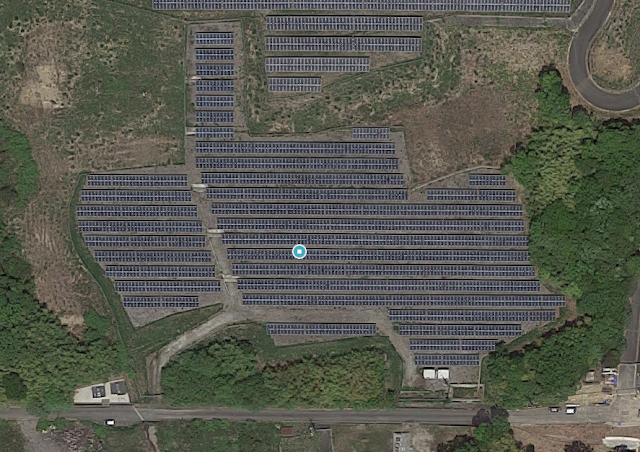 |
| Kurosecho Mega Solar |
The next day, as I passed from Kasai-shi, Hyogo Prefecture, into Kato-shi, I rode near yet other projects we had worked on. These two, in the Takaoka district of Kato-shi, were done as "floating solar" projects on irrigation/adjustment ponds. We co-developed them with the leading manufacturer/designer of the pontoons for these installations, and sold them pre-construction to a major Japanese company's affiliate. They built the projects and, upon commencement of operations, the larger of the two was the largest floating solar PV power plant in the world. That status lasted for only a month or two, until a larger, similar project was completed in Kasai-shi to the west.
 |
| Floating solar PV in Kato-shi, Hyogo |
I did not pass any other solar PV projects I felt any connection to during the remainder of the trip, though I think I saw more larger-scale residential solar PV on the Shimokita Peninsula in Aomori than just about anywhere else I can remember. I guess this area, on the Pacific side of Aomori, gets relatively good sunlight.
Later on the second day of my trip, after passing Maizuru where I reached the coast of the Sea of Japan, I entered Fukui Prefecture and cycled along the "nuclear Ginza".
I first passed through Takahama, infamous in recent years as the place where Kansai Electric executives got massive kickbacks from a local construction boss and former Deputy Mayor, Eij Moriyama. When Moriyama died, this all came out into the public and the entire top executive ranks of Kansai Electric needed to resign, though they miraculously escaped criminal prosecution.
The town had some spectacular public infrastructure -- great town hall, great sports facilities. The nuclear plant was out of sight (in fact, ALL of them were out of sight along the nuclear ginza).
The town's "character" had a prominent place on the sign as I entered town.
I guess the character, Akafun Bouya, is supposed to be a little boy. But on the sign coming into town, I wondered ... is that supposed to be an old man? It certainly looked like an old man, with the shaved head. I wondered, is that perhaps supposed to be Eiji Moriyama, who was partly responsible for the lovely town hall and sports facilities and is the most famous resident of Takahama town (from my perspective, at least)? What a joke that would be!
Alas, upon my return home I looked up Moriyama's image, and he did not have a shaved head or look anything like Akafun, at least not at the age when he was giving suits with 99% pure gold plates sewn into the lining to the Kansai Electric executives.
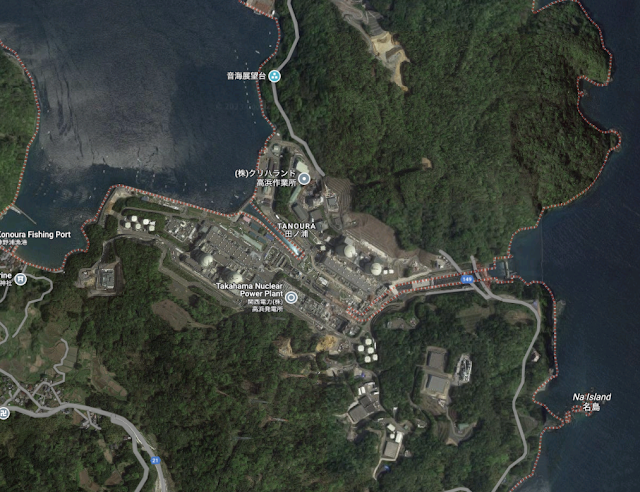 |
| Takahama Nuclear Plant |
The next town was Oi. They also have a nuclear complex, one that also has been in litigation since the "restart", with 2 older units now shutdown and 2 newer ones operating.
 |
| The Oi Nuclear complex |
Then it was Obama -- a nuclear free town so far as I could tell.
After a turn north, I was in Mihama, the site of yet another nuclear complex, far away from the town center and the highway on which I was cycling.
 |
| Mihama nuclear complex -- out of sight, but not quite out of mind? |
And finally, I made it to Tsuruga, home of the Monju experimental fast breeder reactor, now being decommissioned, and the Tsuruga nuclear plant complex, where restart efforts have been stymied so far due to serious inaccuracies in "cleaned up" data submissions to the regulator by the operator, on the question of whether a particular unit of the plant is located directly on top of an active nuclear fault.
 |
| Lower left - closed down Monju; Upper right - Tsuruga nuclear plants one of which still might be restarted. |
Finally I had run the gauntlet, as I headed North along the coast from Tsuruga into Fukui Prefecture. I would go far south of the Shika plant on the Noto Peninsula. The next major nuclear installation I would not ride by until the following evening, as I passed Kashiwazaki Kariwa in Niigata, the site of seven TEPCO reactors, none currently operating. These reactors should be visible from down the coast during day, but it was night and I was passing inland of them, so I could see only some red lights on towers in the dark.
 |
| Kashiwazaki Kariwa - TEPCO's complex in Niigata |
I had passed close to about half of Japan's nuclear reactor fleet at this point, and enjoyed a nuclear-free zone for quite awhile in Yamagata and Akita.
Aomori, on the other hand, has placed a major bet on the nuclear fuel cycle, with the massive Rokkasho-mura reprocessing plant. Construction started in 1993 and, 30 years and $20 billion plus later, it still is not done. But that money has contributed a lot to the economy of the Shimokita Peninsula. And there have been attempts to promote other energy businesses -- the biggest onshore wind farms I have seen in Japan, some massive solar PV facilities, a big oil tank farm, one completed and one under-construction nuclear reactor at Higashidori, etc., etc.
 |
| Rokkasho village reprocessing plant, solar, tank farm, etc. |
The Kamikaze - a Tailwind along the Sea of Japan
I don't have any photos of the low point of my ride. That was around 4AM in pitch dark and pouring heavy rain, when my rear tire flatted.
On this ride I was running new Schwalbe Pro One 700x30 tubeless tires, with sealant, but wherever the leak was that night, the sealant did not work -- air quickly left the tire again when I tried to pump it back up. I added some IRC "Respawn" foam sealant ... and the tire still did not reseal. Eventually, completely soaked and digging around in my bag for the needed tools, I managed to take off the rear wheel, remove the tire, remove the valve for the tubeless setup, insert a tube, re-inflate the tire and get the wheel back on the recumbent (which is somehow much more difficult than on my road bikes). But it took quite awhile, and I lost a pair of bone induction earphones somewhere in the dark by the side of the road.
The rain continued hard and I was in extreme exhaustion/panic mode until I reached my very basic hotel around 630AM, over an hour later than I had planned. I was soaked. I was worried that my iphone might suffer water damage (indeed, I needed to "override" a caution warning to allow it to recharge when moisture was detected in the charger area). Everything I had was wet. I paid an extra 1000 yen at the front desk for an 11AM rather than 10AM checkout, on Sunday morning, warmed in the bath, and slept a few hours.
When I left my hotel room at 11AM, the rain had stopped. I cleaned the bike ... especially cleaning and re-lubing the chain. I did not ride away until nearly 11:45, and stopped for a ramen lunch after around 8 kms of my ride. So it was a slow start to the day, but at least a real reset.
My weather app showed that I would have a nice tailwind for the next segment -- a "kamikaze" or god wind to push me forward. And it proved accurate. The ride to Murakami was nothing special, but as soon as I came out onto the coastline north of Murakami just before 4PM, I could feel a very strong tailwind and see the beauty of this coastline in late afternoon. The next stretch -- overnight to Akita City -- was one of the best of the entire ride, especially the late afternoon-sunset period. I was on Route 345 along the coast, while Route 7, the "main road" up the Sea of Japan coast, takes an more internal path. There was relatively little up and down, there were spectacular rocks jutting up out of the coastline ... that the road went right through via tunnel.
 |
| A rest area just north of Murakami |
 |
| Looking south from just north of Murakami |
 |
| There seemed to be dozens of little coves with rocks and small islands offshore |
 |
| Magical light before sunset |
 |
| A lighthouse visible on a line of rocks offshore. |
 |
| Moonlight, 11PMish. |
 |
| The Kamikaze |
08 May 2023
Magic Hours on the Honshu End-to-End ride -- Early Morning in Hyogo, Early Evening in Niigata
Many of the most mysterious, spectacular moments I have enjoyed in long-distance cycling in Japan come around the beginning and end of daylight. The light can give a special glow or mysterious feeling to even an ordinary landscape, though it is not always easy to capture this in photographs. Also, these times of day offer a hope of solitude and little-to-no traffic not likely to be found in mid-day.
On my end-to-end ride, my first experience of such a "magic hour" was around dawn of April 28, as I rode through Hyogo Prefecture -- Kasai-shi, Kato-shi, and Nishiwaki-shi.
 |
| At Himeji, just before heading Northeast |
 |
| Dawn at Kasai-shi |
 |
| A wider angle view |
 |
| These flowers actually belong to a house out of the photo on the righthand side ... |
 |
| Low traffic cycling! |
 |
| Entering Kato-shi |
 |
| Along the Kakogawa |
 |
| Bike and rider take a photo rest |
 |
| River fog nearby, a high voltage tower emerges |
 |
| The last of the fog, less than an hour later. |
 |
| Azaleas in bloom ... but the magic hour is past. |
That evening, as I passed through southern Niigata, after enduring the tunnels west of Itoigawa, I caught just a bit of magic at Benten-iwa, a shrine on a rock just offshore. But rain was approaching and I was not only exhausted but trying to make decent time before the rain caught me, so could not enjoy the moment as much as I might have.
 |
| Looking back at Itoigawa from the bike path that led to the East for a few kilometers |
 |
| At Benteniwa |
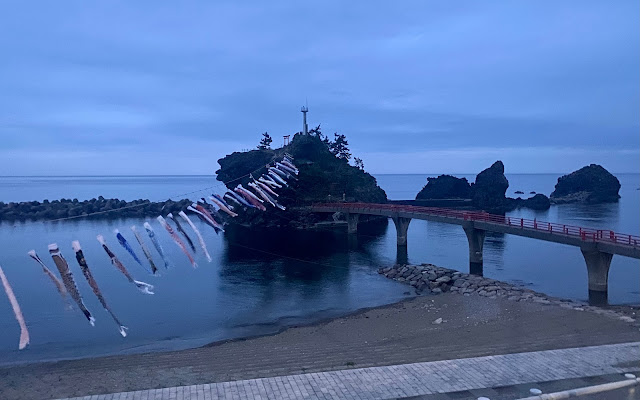 |
| This time without the rain in the foreground |
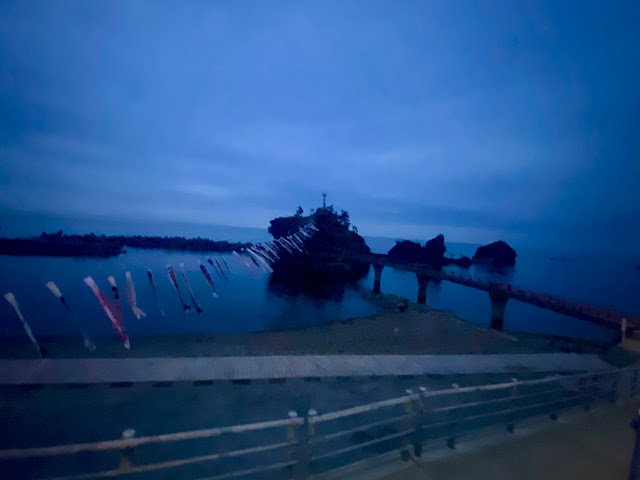 |
| A wider angle, darker image |


